5. 1 GENERAL REMARKS
The excavation of the second season was carried out at the Paleolithic site
of Mugharat ad Douara I in 1974, This site, simply called the Douara Cave,
is the biggest of some dozen caves located along the margin of the southern
rocky slope of the mountain, Jabal ad Douara (or Dawwara). It is 18 km northeast
of Palmyra, which is the biggest oasis in the Syrian Desert. The cave opens
to the southeast, having a slope in front of it (Fig. 5. 1; Photo 5. 1a).
For further details about the location, form, and surroundings of the site,
as well as the findings of the excavation in the first season, see the previous
reports of the Tokyo University Scientific Expedition to Western Asia (Suzuki
and Kobori, 1970; Suzuld and Takai, 1973; 1974).

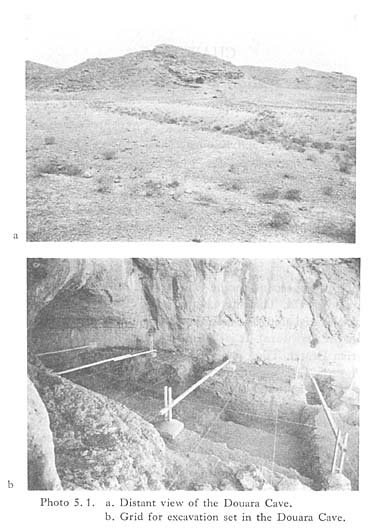
In this season, the main trench excavated in 1970 was widened in order to make further analysis of the Paleolithic industries and the nature of the deposits in relation to the contemporary circumstances and climates. Three test trenches were also excavated in front of the cave on the slope of the mountain, along a small wadi running out from the vicinity of the cave. The purpose of the excavation outside the cave was to investigate the relationship between the deposits in the cave and those of the slope of the mountain. The spatial relation of these excavated localities is shown in Fig. 5.1.
The excavation work in the Douara Cave was directed by T. Akazawa on the prehistoric aspect, while the work on the part of the deposits yielding the Upper Paleolithic industry was directed by T. Fujimoto. At the same time, the deposits were examined by K. Endo from the sedimentological point of view. The excavation of the test trench outside the cave for the sedimentological investigation was directed by K. Endo. The engineering work to meet the requirements of prehistoric and sedimentological investigations, such as the setting of the coordinate system for the various measurements needed in the excavation and making of the lacquer-film preparation of the stratigraphy, was done by B. Endo.
A minute method of excavation, such as was done by Tixier (1970), might have been the best way to obtain precise data from the excavation, but we had only limited time and finances. Thus, for this season, we selected the method of excavating unit-block by unit-block.
5. 2 METHOD OF EXCAVATION IN DOUARA CAVE
A datum point is always necessary for measurement in an excavation. The
point was already marked in 1970 on the surface of the wall at the center
of the back of the cave. It was designated as Point (7,0,0) in [m] in the
three dimensional XYZ-coordinate system, in which X and Y were horizontal
axes crossing each other at right angles, whereas Z was the perpendicular
axis. The Y axis was made parallel to the longitudinal axis of the cave. The
relationship between the coordinate and the cave is shown in Fig. 5. 2. The
datum point was 552.8 m above sea level, and the horizontal axis of Y pointed
to E 19°S. The same coordinate had already been used in 1970.
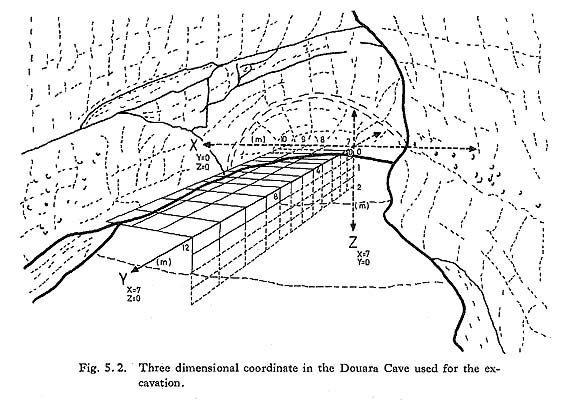
A new hole, with a diameter of 6 mm, was made with a stone-drill in the wall at the datum point and a small bolt was planted in the hole with a lead attachment. An iron post was perpendicularly erected with cement on the rock at a point along a YZ plane, passing through the datum point. Then, a horizontal grid, representing the XY coordinate, was made at an interval of 1 m. The actual grid consisted of wooden beams and rubber strings, fixed either to the bolt embedded into the wall of the cave or to the wooden post. The wooden beam was suspended by wires to keep it straight in the same way as a suspension bridge. The bottom of the post was embedded in the heavy square cement block placed on the surface of the deposit. This was done in order to avoid the destruction of the deposit by striking the post into the earth. Measurements for the excavation were made directly from this grid by designating the position by three dimensional coordinate numerals.
Thus, the deposit of the cave was divided into unit-columns having a square
cross section of 1 m × 1m, according to the grid (Fig 5. 3; Photo 5.
1b). The square column was then divided vertically at intervals of 10 cm.
In this way, the unit-block for ex cavation was determined.
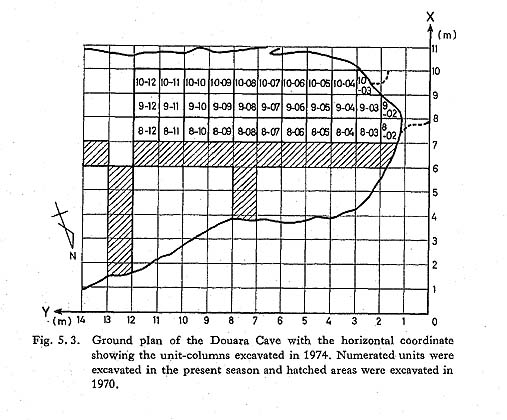
In this season, 33 columns were excavated up to Z=190cm or 160cm, in the region south of the trench made in 1970. These unit-columns are shown in Fig. 5. 3 by the two-dimensionally designated numerals.
The excavation was made unit-block by unit-block. But the unit-block was
often divided into subblocks according to significant stratigraphical separation.
The whole blocks and subblocks of the excavation are shown in Fig. 5. 4, with
each block being represented at its southern side, and drawn in the perpendicular
YZ plane. All the blocks were designated as seen in the figure.
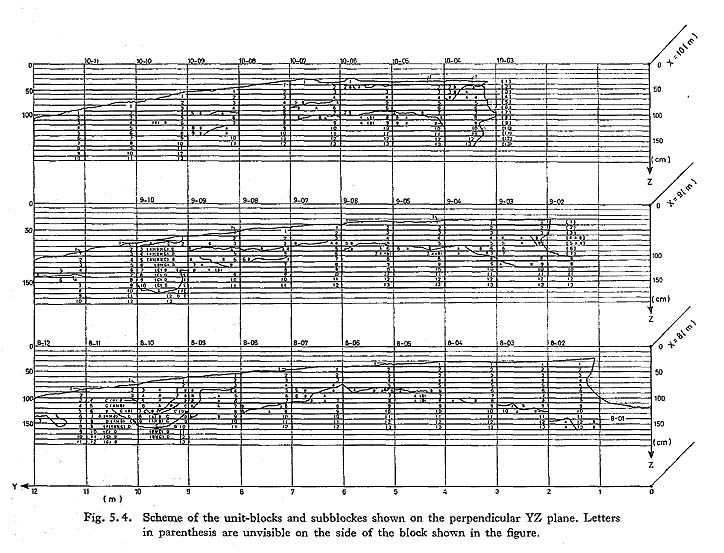
Small trowels, picks and screw-drivers, as well as small painting brushes and dust pans, were the tools for digging. Prehistoric or Paleontological findings found in situ were carefully examined and arranged according to the block or subblock of excavation. The rest of the deposit of each block was separately sieved with a mesh of ca. 3 mm. Small specimens found in the screening were also arranged according to the block or subblock.
5. 3 OUTLINES OF FINDINGS IN DOUARA CAVE
The stratigraphic units determined, as shown in Fig. 5. 5, consist of four
horizons: I, II, III and IV (see Chapter 4). Horizon I denotes the uppermost
deposit that covers the entire excavated area. Horizon II broadly corresponds
to Layers A and B as defined in the 1970 season's stratigraphy (Akazawa et
al., 1973: 22-26). The distribution of this layer is restricted to four unit-columns
of 8-10, 8-11, 9-10, 9-11 in the exterior part of the cave. It is missing
in the interior of the cave, inward from the line at Y=9. The lithic assemblage
found in this horizon is of Epi-Paleolithic character while the assemblage
from the succeeding horizons is of the Middle Paleolithic. Horizons III and
IV correspond in general to the Layers D and E respectively of the 1970 season's
stratigraphy. They are distributed throughout the excavated areas. Each of
Horizons II through IV is divided into two stratigraphic units: A and B. The
Stratigraphic Unit B of Horizon IV is the deepest deposit excavated in the
1974 season and is characterized by Middle Paleolithic hearth deposits.
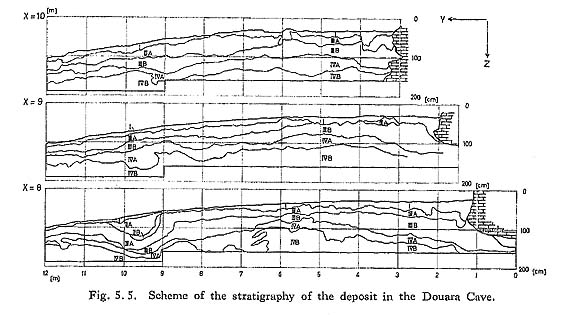
5. 3. 1 Horizon I
The collection of artifacts from this horizon is not homogeneous. Although it is a very thin deposit, it contains a small number of Epi-Paleolithic and Neolithic artifacts such as naviform type cores, as well as a large quantity of Middle Paleolithic artifacts. In addition, it contains some potsherds, glass, and bronze tools that presumably belong to the Roman and Islamic periods. The above lithic assemblages of Middle and Epi- Paleolithic types have the same morphological and technological features as those of assemblages from the succeeding horizons. But no other horizon yields the lithic arti facts of Neolithic types or potsherds and bronze tools.
The physical condition of flints from this horizon is markedly different from that of other horizons. Included in the lithic collection are a large quantity of small frag mental pieces probably broken as a result of thermal action, but which are definitely not chips. Almost all of the flints are more or less abraded and usually patinated black to very dark brown with a luster. On the whole, these contrast with the fine, clean condi tion and usually brown color of theflints from the underlying Horizon III. Such context and condition of Horizon I artifacts imply that this horizon may not be a primary deposit.
5. 3. 2 Stratigraphic Unit A of Horizon II (Unit II A)
The collection from this unit is dated to the Epi-Paleolithic. The artifacts here have more calcareous concretion than those of Unit B and they are light brown to black in color and have a white cortex. The total collection consists of retouched pieces and blanks of various kinds. Blanks include flakes, blades, bladelets, cores, and core-re juvenated flakes, and they are highly microlithic.
Flakes occupy four fifths of the total quantity of artifacts. Blades and bladelets are mostly broken and are classified as parallel-sided blanks made by punch-technique: those less than 15 mm in widths become bladelets and the rest are blades. However, this classification is arbitrary.
Cores are found in fairly large numbers. They are made on large flakes or flint peb bles and mostly are of the prismatic type. Many are uni-directionally flaked with single faceted platforms. Fairly large numbers of core-rejuvenated flakes are also found in association.
Retouched pieces are very few in number, occupying only 2% of the total quantity of artifacts, and of these, two thirds are microliths. Among the microliths, trapeze rectangles are characteristic and are the dominant type. Most of them are broken but they show a certain uniformity, both technologically and typologically. Proxirnal and distal micro-burins are found. Trapezes may have been made by the micro-burin technique. Among the microliths, there are many backed bladelets, including frag ments of trapeze-rectangles. Retouched and truncated bladelets of various kinds are also to be found.
On the other hand, tools of ordinary size include gravers, end-scrapers and core scrapers. Truncated blades, borers, notched pieces and retouched pieces are also seen but are quite rare. The gravers of dihedral type, beaked type and types made on trunca tion or lateral preparation are seen. They are made on blades and those made on flakes are roughly made. In addition, graver-spalls are found and they coincide with the scars of graver-facets. This implies that the actual production or rejuvenation of gravers was performed at this unit. Of the end-scrapers, those on blades are most dominant but an end-scraper on a short flake with a denticulated edge is also found. Although not typical, this specimen resembles the scrapers of the Ksar Akil type. Another specimen has edges on both ends. The last type, core-scrapers, are fairly abundant. They are made from prismatic cores and the edges of some of them are broken.
5. 3. 3 Stratigraphic Unit B of Horizon II (Unit II B)
Specimens collected from this unit are datable to the Epi-Paleolithic. Artifacts in this unit are almost identical to those of Unit II A. They are light brown to black in color, with a white cortex, and have light calcareous concretion on their surfaces. Many artifacts, especially cores and large tools, have a cortex.
Flakes are most abundant and account for seven eighths of the total quantity of specimens. The next most common specimens are bladelets. Blanks in this collection are highly microlithic.
Cores and core-rejuvenated flakes are present, too. Cores are of the prismatic type, and most of them are uni-directionally flaked. Most of them have been modified into core-scrapers.
Of the retouched pieces, microliths are dominant and characteristic. They number less than 2% of the total quantity of artifacts. Among the microliths, trapeze-rectangles are the most characteristic tools. They are similar to one found in Unit A. As in that unit, trapezes may have been made by the micro-burin technique in this unit. In addi tion, there are a large number of backed bladelets in broken pieces. On them, there are various types of retouch. Proximal and distal micro-burins are seen, too. However, they may be merely waste as a result of trapeze production.
As in Unit A, various gravers are seen. They are dihedral or beaked or are made on broken end or lateral preparation. The end-scraper is atypical and is made on a flake. It has edges at both ends: at the proximal end on the ventral surface and at the distal end on the dorsal surface. In association, core-scrapers are found in fair number. They are modified from prismatic cores. No borers, truncated pieces, or typical end-scrapers are seen in this unit.
5.3.4 Epi-Paleolithic assemblage
Some differences are observed on several points between the assemblages of Unit II A and Unit II B, but these two assemblages are basically the same. The ratio of blanks is similar and the assemblages of both units have a large number of non-retouched pieces, these being one of the most characteristic features of the assemblages. The ratio between blades and bladelets, whose production systems are precisely the same, is identical. They are flaked from uni-directional and prismatic cores. Thus, technologi cally, the assemblages of both units are identical.
The blanks and retouched pieces of Units II A and II B are microlithic. Their most characteristic tools are trapeze-rectangles. They have a certain quantity of micro burins. It is probable that trapezes of these units are formed by the micro-burin tech nique. There is a difference in the ratio of microliths, but the same types are found in both assemblages.
In ordinary-sized tools, the assemblages of both units have the same types of gravers. Dihedral and beaked gravers and types of gravers on lateral preparation are seen in both assemblages. The ratios of types of gravers are similar. Core-scrapers, modified from the prismatic type of cores, are seen in both assemblages. Retouched and notched pieces are also seen in both assemblages.
The differences between these two assemblages are observed in borers, truncated pieces, and typical end-scrapers on blades. These are not found in the assemblage of Unit B. Likewise, a scarcity of scrapers is observed in the assemblage of Unit B. The assemblages of both units, especially Unit B, have small number of tools. It is probable that the differences between the assemblages of Units A and B have arisen merely accidentally. In the investigation of the 1970 season, borers and truncated pieces were found in Layer B. Thus, the two assemblages also coincide from the typological point of view.
As for traces of wear, the same traces are observed at the same positions in the same type of tool at both assemblages.
As mentioned above, concerning the technological, typological and functional fea tures of tools, the identity is observed between the assemblages of the Units A and B. It is summarized as follows:
1) A large amount of non-retouched pieces are seen, and cores and core-rejuvenated flakes are found in fairly large numbers.
2) The assemblages of both units are microlithic in blanks and tools. In retouched tools, microliths occupy about two thirds of the total. Among microliths, trapeze rectangles with widths of 6-9 mm are abundant. Trapezes may have been made by the micro-burin technique.
3) The ordinary-sized tools occupy one third of the total. Among ordinary-sized tools, gravers of various types, end-scrapers on blades and core-scrapers are representa tive.
The assemblages of Unit II A and Unit II B have the features mentioned above. They coincide with the general features of Geometric Kebaran A of Bar-Yosef (Bar- Yosef, 1970; 1975; 1976), especially in the aspects of having fairly large numbers of trapeze-rectangles. A detailed description of these assemblages will be given in a final report.
5. 3. 5 Stratigraphic Unit A of Horizon III (Unit III A)
The artifacts found in this unit are not as homogeneous as those of the underlying units. The majority of the lithic artifacts closely resemble those of the Levantine Mous terian assemblage from the unit below. But mixed with them are very few potsherds and bronze tools and flint implements of non-Paleolithic character. It is also noteworthy that a considerable proportion of flints are broken and have a black to very dark brown patina, presumably caused by fire.
This evidence suggests the possibility of this unit being a secondary or disturbed deposit. However, this question requires further analysis of the geology in order to determine the exact nature of this unit, including its relationship to the associated lithic assemblage.
5. 3. 6 Stratigraphic Unit B of Horizon III (Unit III B)
This unit produced the largest quantity of lithic artifacts of all the stratigraphic units of Horizons III and IV. The prominent feature of the assemblage of this unit is the high frequency of the Levallois technique used in the production of tool blanks and the high percentage of blanks having faceted striking platforms pertaining to the Levantine Mousterian industries as defined in a number of sites in Western Asia. The physical condition of these flints is usually clean, unabraded and of bright color in contrast to lustrous and dark color of flints from the overlying deposits.
A large number of ostrich (Struthio sp.) eggshell fragments are found in the deposits. Although they are found in both Unit III A and Unit IV A as well, they are concen trated mostly in this unit. All in all, Unit III B is characterized by deposits of a rich Levantine Mousterian assemblage as well as a large number of ostrich eggshell frag ments, without the associated non-Paleolithic flints and potsherds.
5. 3. 7 Stratigraphic Unit A of Horizon IV (Unit IV A)
From this unit, the lithic artifacts decreased in number. The lithic assemblage is broadly characterized as exhibiting Levantine Mousterian features. But on closer examination, its features are found to be different from those of the overlying Unit III B. One of the most striking features of this assemblage is the relatively low frequency of the Levallois technique in the production of tool blanks. This contrasts with the dominance of the Levallois technique in the manufacture of blanks in Unit III B. The above tendency is observed more clearly in the assemblage of the succeeding Unit IV B.
The abrasion and patination of the flints of this unit are variable. The outstanding physical characteristic of the flints is that a considerable number of flints show some abrasion and are in a brittle condition, presumably caused by fire, and are patinated bluish to very dark and blackish-gray in color. This evidence is also emphasized in the following assemblages from Unit IV B.
6. 3. 8 Stratigraphic Unit B of Horizon IV (Unit IV B)
This unit corresponds to the hearth deposits containing a number of ash
beds and hearth streaks in the matrix of whitish or grayish to blackish stained
earth mixed with some organic matter. The hearth band is very thick, ranging
from 50-60 cm in the thickest parts (8-04 to 8-06, 9-04 to 9-06) to 20-30
cm and is outlined by an arrange ment of limestone fragments and a series
of very compact concretions. The stones are usually reddish yellow and are
brittle as a result of thermal action. A dense ash concretion is found in
the area defined clearly by a series of these stones and concretions (Fig.
5.6; Photo 5. 2a, b).
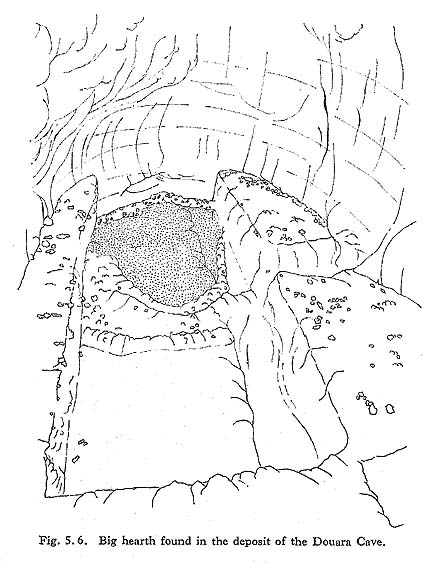
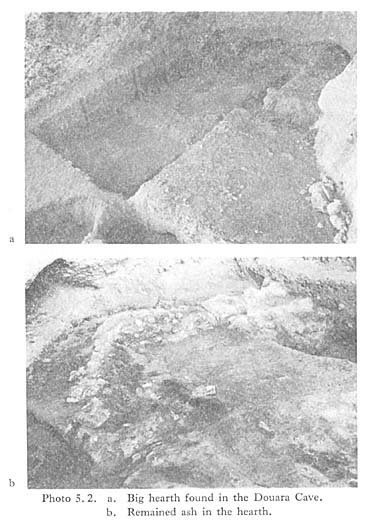
The lithic assemblage from this unit is markedly different from that of the overlying Unit III B. The flints are usually patinated bluish or blackish-gray, or very dark gray. A large number of them show breakage, perhaps caused by fire, and are easily broken. The frequency of the Levallois technique drops. A large proportion of these blanks are characterized by an elongated form with a non-faceted striking platform. This contrasts with the significant presence of multidirectional, broad flakes of the Levallois type in the manufacture of blanks in Unit III B.
5. 3. 9 Middle Paleolithic assemblage
Finally, the relationship between the Middle Paleolithic assemblages of the two horizons, III and IV, can be broadly summarized as follows:
1) The figure of the Levallois Index of Horizon III is significantly larger than that of Horizon IV. This is due to the high proportion of Levallois and discoidal type cores as well as the Levallois type blanks in the assemblage of Horizon III. On the other hand, the Levallois Index of Horizon IV is low compared to Horizon III, though it should not be ignored. In Horizon IV, the non-Levallois technique predominates in the forms of specific cores of the prismatic and flake type.
2) Both horizons contain a collection of elongated blanks, although the quantities differ. Horizon IV holds an exceedingly high Blade Index, a tendency which is unlikely in the Middle Paleolithic context of the Levant. Of the elongated blanks, the majority are produced by the non-Levallois technique in Horizon IV and the Levallois technique in Horizon III.
3) Secondarily retouched tools are rare in both horizons. Since there are very few Levallois type blanks in Horizon IV, they naturally have very few unretouched tools, that is Levallois flakes and points. This evidence makes it clear that the assemblages of Horizon IV are typologically dissimilar to any known Levantine Mousterian industry. In contrast, the typological characteristics of Horizon III readily conform to the Le vantine Mousterian assemblages.
5. 4 EXCAVATION AT WADI FAN
The excavation followed a grid system. Each of the trenches was made into grids of one meter square; each unit was excavated in 10 through 50 cm arbitrary levels, and all artifacts within these units and levels were recorded.
Thus, during 1974 the excavation was carried out in three trenches designated
as WF-1, WF-2, and WF-3. WF-1 was composed of six units, WF-2 of five units
and WF-3 of seven units. The depth of the excavations varies from 0.25 m to
about 3 m (Figs. 5. 7/9).
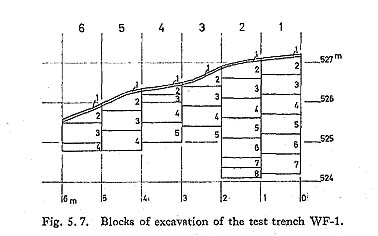
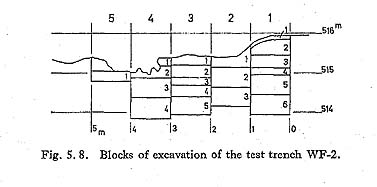
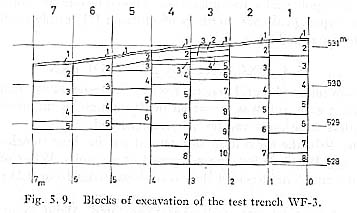
In these trenches a total area of 18 m2 was excavated. About 35 m3 of the deposits was removed in all. Excavated sediments were screened through a mesh of ca. 3 mm to increase atrifacts recovery. Among very large artifacts, numerous small-sized artifacts were recovered.
As shown in Fig. 5. 10, the stratigraphic units of the WF trenches consist
of six layers: Fan gravels I through VI (see Chapter 4). With the exception
of a very small collection from Fan gravels V and VI, the material of each
layer is in sufficient quantity for us to compare those assemblages quantitatively
and qualitatively within themselves and with other assemblages from relevant
sites such as the Douara Cave. The general features of the collections from
each layer are as follows.

5. 4. 1 Fan gravel I
The collection of this layer is not homogeneous. The majority of lithic artifacts closely resemble those of the pre-Pottery Neolithic industry in the Levant. These fall into several types according to typological features, but the following types of artifacts are the most distinctive and conspicuous: Naviform type core and crest blades, plung ing flakes and core tablets produced in the preparation of the naviform cores, and a large number of blades removed from the naviform type cores. These PPN flints are mottled mahogany and very brown in color and are in fresh condition, but almost all pieces have extensive edge-damage along their margins from natural crushing.
Together with these, a very small number of Upper and Middle Paleolithic flakes and cores are present although these pieces are proportionately negligible. Some blades and cores can be classified as Upper Paleolithic in character; the Middle Paleolithic flints consist of some Levallois flakes.
The physical condition of these Paleolithic flints is different from that of the above PPN flints. In the Upper Paleolithic group, there are some specimens characterized by having the same features as those of the PPN flints. However, the majority of Upper Paleolithic groups are usually light brown and light gray and are more abraded than the PPN flints. These flints also have edge-damage from natural crushing.
5. 4. 2 Fan gravel II
Again, in this layer, PPN type flints predominate in the total collection. The techno typological features and the physical condition of these types of flints are exactly the same as those of the overlying layer.
The outstanding feature of the collection in this layer is that the proportion of the Middle Paleolithic type of flint is greater than that of the preceding layer. Among the total samples identified clearly, more than 20-30% consist of Levallois cores and flakes of all types. The physical condition of these Levallois type flints is light to brown and dull brown in color, in contrast to the flints of the associated PPN type with mahogany and dark brown color.
The next striking feature of the collection in this layer is that a small number of bluish and very dark colored flints are to be found. Although these flints of peculiar color are all fragmentary, all of them are classifiable as Middle Paleolithic type flints. In general, the materials are abraded and rolled, and all of them have small patches of calcareous concretions adhering to their surfaces. The features of these flints closely resemble the bluish to blackish and very dark gray flints of Levallois and non-Levallois type as sociated with Unit B of Horizon IV of the Douara cave. Their appearance suggests that they are derived from the Douara cave.
It is clear that Upper Paleolithic type flints are included in this collection, but the proportion of these types is completely negligible.
5. 4. 3 Fan gravel III
The nature of the collection from this layer is completely different from that of the preceding layers. The most striking feature is that the whole collection consists of various Levallois cores of Middle Paleolithic type and various Levallois flakes. Specimens classifiable as Levallois elements are mostly typical. Many of the Levallois flakes are of the broad type and are generally characterized by multidirectional and elaborate preparation of the striking platforms. The outstanding feature of these Levallois ele ments is their patination, which is usually a dull white and cream color, and the ex tensive edge-damage along their margins from natural crushing. These Levallois flints of all types closely resemble the Levallois cores and flakes discovered in Unit B of Horizon III of the Douara cave, with the exceptional difference of their physical condi tion.
Again, in this layer, fragments of bluish to very dark colored flint are included. Their features are exactly the same as those of the preceding Fan Gravel II, but the number of these fragments increases in this layer. At the top part of this layer, in par ticular, they are found in large number and show a slight decrease going downwards.
Lastly, there is a great number of small fragments found in this layer. In particular, thousands of these fragments of various colors and degrees of abrasion are collected from Fan Gravel III of the WF-1 trench. Their breakage is caused by natural crushing.
5. 4. 4 Fan gravel IV
The number of flints from this layer is significantly smaller compared to the over lying layers. All the specimens classifiable definitely fall into Middle Paleolithic of the Levallois type. The techno-typological characteristics of these Levallois type flints are broadly the same as those of the overlying Fan Gravel III. However, it is not possible to conclude whether the assemblages resemble one another because the sample size of Fan Gravel IV is small and almost all the pieces are fragmentary. All specimens are patinated in a deeper white to cream color than the flints from Fan Gravel III. Edge damage of the flints is extensive.
Bluish and very dark-colored flint fragments mentioned in the preceding Fan Gravels II and III were not discovered in this layer, although occasionally such flints were collected, suggesting a mixture with the flints of the overlying layer presumably caused accidentally during excavation.
LITERATURE CITED
- Akazawa, T., Baba, H. and Endo, K. (1973)
- Investigation of the Douara Cave Site. In: Suzuki and Takai (eds.), The Palaeolithic Site at Douara Cave in Syria. Part I. Univ. Mus., Univ. Tokyo, Bull. No. 5, pp. 9-27.
- Bar-Yosef, O. (1970)
- Prehistoric Sites near Ashdad, Israel. Palestine Exploration Quarterly, 1970 Jan.-June, pp. 53-69.
- Bar-Yosef, O. (1975)
- The Epipaleolithic in Palestine and Sinai. In: Wendorf and Marks (eds.), Problems in Prehistory: North Africa and the Levant. Dallas. pp. 363-378.
- Bar-Yosef, O. (1976)
- A Note on the Geometric Kebaran A. Preconference papers for IXth International Congress of Prehistoric and Protohistoric Sciences, Nice, Colloque III, pp. 78-105.
- Suzuki, H. and Kobori, I. (eds.) (1970)
- Report of the Reconnaissance Survey on Palaeolithic Sites in Lebanon and Syria. Univ. Mus., Univ. Tokyo, Bull. No. 1.
- Suzuki, H. and Takai, F. (eds.) (1973)
- The Paleolithic Site at Douara Cave in Syria. Part I, Univ. Mus., Tokyo, Bull. No. 5.
- Suzuki, H. and Takai, F. (eds.) (1974)
- The Palaeolithic Site at Douara Cave in Syria. Part II, Univ. Mus., Univ. Tokyo, Bull. No. 6.
- Tixier, J. (1970)
- L'Abri sous Roche de Kasr 'Aquil. La Campagne de Fouilles 1969. Bull. Mus. Beyrouth, T. 23, pp. 173-191.